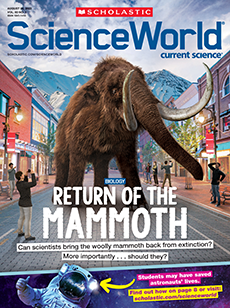Mix certain elements, like sodium (Na) or potassium (K), with water and—BOOM! The reaction will create a major explosion. But when scientists recently tried a new version of this experiment, something unexpected happened.
The researchers released a mist of water vapor into an airless chamber that contained a droplet of liquid sodium and potassium metals. The water condensed, or turned from gas to liquid, sticking to the droplet’s surface. Instead of triggering a BANG, the water formed an ultrathin golden film around the droplet.
Electrons, or negatively charged particles, passed from the metal mixture into the surrounding water. This caused the water to reflect light and conduct electricity—just like a metal. The experiment shows that even well-known reactions hold surprises, says Ryan McMullen, a chemist at the University of Southern California.
